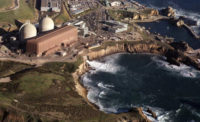Power
California Extends Diablo Canyon Nuclear Plant Operations Until 2030 to Boost Grid Reliability

With approval by the state, California's Diablo Canyon nuclear power plant will now begin the regulatory effort to continuing operations past 2025.
Photo by AP/ Michael A. Mariant
California’s last operating nuclear power plant, Diablo Canyon, has been given a new lease on life after Gov. Gavin Newsom signed into law a measure allowing it to remain open past its scheduled 2025 shutdown date.
The plant, located in San Luis Obispo County, was slated for decommissioning with the expiration of its current operating license. Keeping the facility online became a priority recently as the state’s aggressive efforts to eliminate carbon-emitting power sources collided with statewide power reliability.
“This is critical in the context of making sure we have energy reliability going forward as part of our energy plan and yes, part of our climate plan,” Newsom said in a press conference. “Because that energy does not produce greenhouse gases.”
Diablo Canyon has been in operation since the mid-1980s and can generate 2,200 MW of baseline electricity. It currently provides approximately 8.6% of the state’s total electricity supply and almost 17% of California’s zero-carbon supply. The new law allows the plant to operate through 2030 and provides its owner and operator, Pacific Gas and Electric Co. (PG&E) a $1.4-billion loan from the state to keep it running.
“We will do our part to help the state achieve its energy reliability and decarbonization goals, while continuing to run one of the top performing plants in the country,” said PG&E CEO Patti Poppe in a statement.
Regulatory hurdles still remain. PG&E must now obtain a new operating license from the U.S. Nuclear Regulatory Commission. State regulators must weigh in as well although the new law instructs state agencies to coordinate with PG&E to fast track the effort to keep the facility operating.
While California is providing the utility funding for the plant’s continued operation, the new law instructs PG&E to seek federal funds to pay back the loan, primarily through the U.S. Dept. of Energy Civil Nuclear Credit program. It is a $6-billion strategic investment under the 2021 Infrastructure Investment and Jobs Act to help preserve the existing U.S. reactor fleet.
Last May, Gov. Newsom made several requests to DOE that would make Diablo Canyon eligible for the funds. These items were later adopted as they applied to nuclear plants nationwide that had already announced intention to cease operation. Among the requests granted was the extension of the application deadline for the first award cycle until Sept. 6.
Environmental groups opposed allowing the plant to continue operating, arguing that it would postpone much needed renewable energy investment. They also argue the plant’s location near a fault line presents a danger.
“The rush by lawmakers and Gov. Newsom to keep Diablo Canyon running is dangerous and dumb and will only set back California’s drive to make solar and wind the prevailing sources of electricity in the state,” said Ken Cook, president of the non-profit Environmental Working Group.
California officials opted to shutter Diablo Canyon in 2016 after the California Public Utilities Commission (PUC) found it was not cost effective to operate and system reliability could be maintained without it. The Nuclear Regulatory Commission's withdrew license renewal for the facility in 2018.
The PUC assessment did not take into the account the state’s ensuing push to require zero-carbon sources for electric power. Reliability needs have grown as well. In 2020, blackouts occurred statewide as available electrical capacity fell below demand due to extreme heat. A current heatwave enveloping the state has prompted calls for electricity conservation to prevent a similar round of blackouts.
On Aug. 31, the governor issued a state of emergency proclamation to increase energy production and reduce demand that was later extended through Sept. 9. Flex Alerts asking for state residents to conserve power have been issued over the week since. On Sept. 6, power grid peak demand hit 52,061 megawatts, a new all-time record although power conservation efforts avoided the need for rolling blackouts.
A Stanford/MIT study last year found that continuing to operate the plant would not only help the state reduce carbon emissions, it would also offer significant power system cost savings while improving reliability.
During the last legislative session, a number of bills aimed at tackling climate concerns were passed. These included efforts aimed at accelerating renewable energy targets, switching to only zero-emission vehicles by 2035 and prioritizing carbon renewal and capture efforts.
Many of these efforts will increase demand on the state’s power grid in the short term while renewable energy sources will still be in development.



